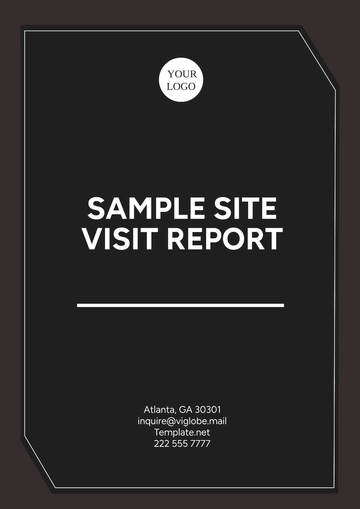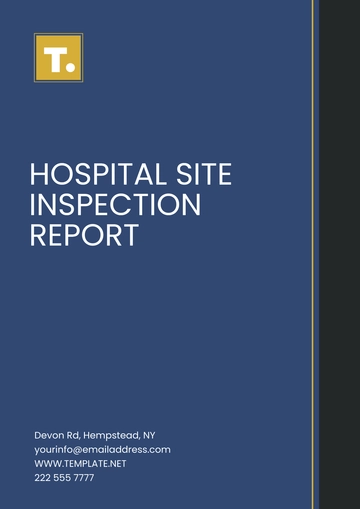Free Manufacturing Site Visit Report

I. Executive Summary
The site visit was conducted at [Your Company Name], located in Long Beach, CA 90801, to assess the production processes, safety standards, and overall facility management. The main objective was to evaluate the current manufacturing operations, identify areas for improvement, and ensure compliance with industry safety and quality standards.
II. Introduction
Date of Visit: December 10, 2054
Location: Jersey City, NJ 07302
Purpose of Visit: To assess the manufacturing processes and identify operational improvements.
Attendees:
John Doe, Manufacturing Operations Manager
Jane Smith, Health & Safety Officer
Mark Johnson, Plant Manager
Linda Brown, Quality Assurance Lead
Host Representative: Mark Johnson, Plant Manager
Duration of Visit: 9:00 AM - 1:00 PM
III. Overview of the Facility
Facility Description: [Your Company Name] is a medium-sized facility specializing in the production of consumer electronics, primarily mobile phones and accessories. The plant spans approximately 50,000 square feet and houses multiple assembly lines.
Key Equipment and Technologies Used: Automated assembly lines, robotic arms for precision assembly, conveyor belts for material handling, and advanced testing machines for quality control.
Certifications and Compliance: The facility holds ISO 9001 for quality management and complies with OSHA safety standards.
IV. Observations
Production Processes: The facility operates a semi-automated production line where components are assembled by robotic arms and tested for functionality before being packaged. The line is well-maintained, with minimal downtime.
Quality Control Procedures: Rigorous testing is conducted at various stages of production, including electronic testing, visual inspections, and packaging verification. The quality assurance team uses statistical sampling to ensure product consistency.
Health and Safety Practices: Safety practices are generally robust, with workers using proper personal protective equipment (PPE), including gloves, goggles, and ear protection. However, there were concerns about the lack of visible fire exits in some areas of the production floor.
Workforce: The workforce appeared well-trained, and operators demonstrated familiarity with the machinery. However, there is a need for additional training on emergency protocols.
Facility Cleanliness and Organization: The plant is clean and well-organized. Production areas are clearly marked, and inventory is stored neatly. However, some storage areas for raw materials could benefit from better labeling.
V. Key Findings
Strengths:
Well-organized production lines with minimal equipment downtime.
Strict adherence to quality control procedures, ensuring high product consistency.
Well-trained workforce with a focus on product quality.
Areas for Improvement:
Fire exit signage and accessibility should be improved to meet safety standards.
Some storage areas are not labeled properly, which could lead to confusion and delays in material handling.
PPE usage is high, but emergency evacuation training could be enhanced.
Challenges Observed:
The facility operates with older machinery, which has the potential for increased maintenance costs and occasional breakdowns.
There is a lack of automated tracking systems for raw materials, leading to occasional delays in production scheduling.
VI. Recommendations
Operational Improvements:
Introduce automated inventory management systems to streamline material handling and reduce delays.
Improve storage area labeling to enhance efficiency in locating and using raw materials.
Safety Enhancements:
Install additional fire exit signage and ensure all exits are easily accessible.
Conduct bi-annual emergency evacuation drills to reinforce the importance of safety procedures among all employees.
Equipment Upgrades:
Upgrade older machinery, especially in the assembly line, to reduce maintenance costs and improve production efficiency.
VII. Conclusion
The visit to [Your Company Name] provided a clear picture of a well-maintained and efficient manufacturing facility. While the plant excels in quality control and production efficiency, improvements in safety protocols and equipment upgrades are recommended to ensure continued operational success. Addressing the identified areas for improvement will help ABC Manufacturing maintain its competitive edge and enhance worker safety.
Prepared By:
 [Your Name]
[Your Name]
Manufacturing Operations Manager
December 15, 2054
- 100% Customizable, free editor
- Access 1 Million+ Templates, photo’s & graphics
- Download or share as a template
- Click and replace photos, graphics, text, backgrounds
- Resize, crop, AI write & more
- Access advanced editor
The Manufacturing Site Visit Report Template, offered by Template.net, is a highly customizable tool designed to streamline your site visit documentation process. This downloadable and printable template allows you to easily record essential details from your visit. Fully editable in our AI Editor Tool, it ensures effortless customization to meet your specific needs, making it the perfect solution for professionals seeking efficiency and precision in reporting.
You may also like
- Sales Report
- Daily Report
- Project Report
- Business Report
- Weekly Report
- Incident Report
- Annual Report
- Report Layout
- Report Design
- Progress Report
- Marketing Report
- Company Report
- Monthly Report
- Audit Report
- Status Report
- School Report
- Reports Hr
- Management Report
- Project Status Report
- Handover Report
- Health And Safety Report
- Restaurant Report
- Construction Report
- Research Report
- Evaluation Report
- Investigation Report
- Employee Report
- Advertising Report
- Weekly Status Report
- Project Management Report
- Finance Report
- Service Report
- Technical Report
- Meeting Report
- Quarterly Report
- Inspection Report
- Medical Report
- Test Report
- Summary Report
- Inventory Report
- Valuation Report
- Operations Report
- Payroll Report
- Training Report
- Job Report
- Case Report
- Performance Report
- Board Report
- Internal Audit Report
- Student Report
- Monthly Management Report
- Small Business Report
- Accident Report
- Call Center Report
- Activity Report
- IT and Software Report
- Internship Report
- Visit Report
- Product Report
- Book Report
- Property Report
- Recruitment Report
- University Report
- Event Report
- SEO Report
- Conference Report
- Narrative Report
- Nursing Home Report
- Preschool Report
- Call Report
- Customer Report
- Employee Incident Report
- Accomplishment Report
- Social Media Report
- Work From Home Report
- Security Report
- Damage Report
- Quality Report
- Internal Report
- Nurse Report
- Real Estate Report
- Hotel Report
- Equipment Report
- Credit Report
- Field Report
- Non Profit Report
- Maintenance Report
- News Report
- Survey Report
- Executive Report
- Law Firm Report
- Advertising Agency Report
- Interior Design Report
- Travel Agency Report
- Stock Report
- Salon Report
- Bug Report
- Workplace Report
- Action Report
- Investor Report
- Cleaning Services Report
- Consulting Report
- Freelancer Report
- Site Visit Report
- Trip Report
- Classroom Observation Report
- Vehicle Report
- Final Report
- Software Report





























